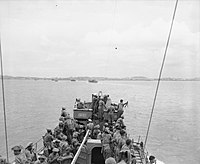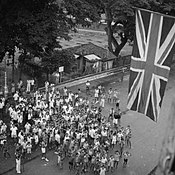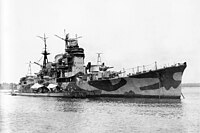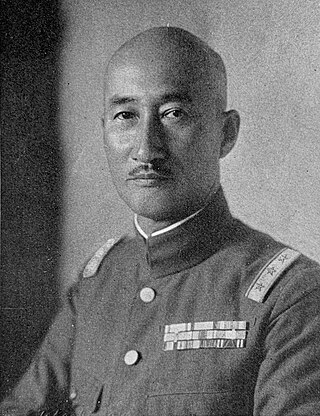
Count Hisaichi Terauchi was a Gensui in the Imperial Japanese Army, commander of the Southern Expeditionary Army Group during World War II.

South East Asia Command (SEAC) was the body set up to be in overall charge of Allied operations in the South-East Asian Theatre during the Second World War.

The sinking of Prince of Wales and Repulse was a naval engagement in World War II, as part of the war in the Pacific, that took place on 10 December 1941 in the South China Sea off the east coast of the British colonies of Malaya and the Straits Settlements, 70 miles east of Kuantan, Pahang. The Royal Navy battleship HMS Prince of Wales and battlecruiser HMS Repulse were sunk by land-based bombers and torpedo bombers of the Imperial Japanese Navy. In Japan, the engagement was referred to as the Naval Battle of Malaya.

The South-East Asian Theatre of World War II consisted of the campaigns of the Pacific War in the Philippines, Thailand, Indonesia, Indochina, Burma, India, Malaya and Singapore between 1941 and 1945.

Myōkō (妙高) was the lead ship of the four-member Myōkō class of heavy cruisers of the Imperial Japanese Navy (IJN), which were active in World War II. She was named after Mount Myōkō in Niigata Prefecture. The other ships of the class were Nachi, Ashigara, and Haguro.
During World War II, Operation Zipper was a British plan to capture either Port Swettenham or Port Dickson, Malaya, as staging areas for the recapture of Singapore in Operation Mailfist. However, due to the end of the war in the Pacific, it was never fully executed. Some of the proposed landings on Penang went ahead as planned to probe Japanese intentions, encountering no resistance. The planned deception for this attack was called Operation Slippery, whilst a small Special Operations Executive team led by Tun Ibrahim Ismail which landed in October 1944 managed to convince the Japanese that the landings were to be on the Isthmus of Kra, 650 miles (1,050 km) to the north.

Syonan, officially Syonan Island, was the name for Singapore when it was occupied and ruled by the Empire of Japan, following the fall and surrender of British military forces on 15 February 1942 during World War II.
Operation Culverin was a planned operation in World War II, in which Allied troops would recapture the northern tip of Sumatra from the Japanese. "Culverin" was a code name for "Operations against northern Sumatra / Malaya" and "First Culverin" was "Operations against northern Sumatra" alone. It was never carried out. Lack of resources prevented it being mounted as originally planned, and other events later made it unnecessary.
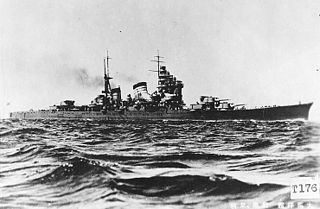
The Battle of the Malacca Strait, sometimes called the Sinking of Haguro, and in Japanese sources as the Battle off Penang (ペナン沖海戦), was a naval battle that resulted from the British search-and-destroy operation in May 1945, called Operation Dukedom, that resulted in the sinking of the Japanese cruiser Haguro. Haguro had been operating as a supply ship for Japanese garrisons in the Dutch East Indies and the Bay of Bengal since 9 April 1945.

Shirakumo was a Fubuki-class destroyer and the eighth in a class of twenty-four vessels built for the Imperial Japanese Navy following World War I. When introduced into service, these ships were the most powerful destroyers in the world. They served as first-line destroyers through the 1930s, and remained formidable weapons systems well into the Pacific War.

Malaya, then under British administration, was gradually occupied by Japanese forces between 8 December 1941 and the Allied surrender at Singapore on 15 February 1942. The Japanese remained in occupation until their surrender to the Allies in 1945. The first Japanese garrison in Malaya to lay down their arms was in Penang on 2 September 1945 aboard HMS Nelson.
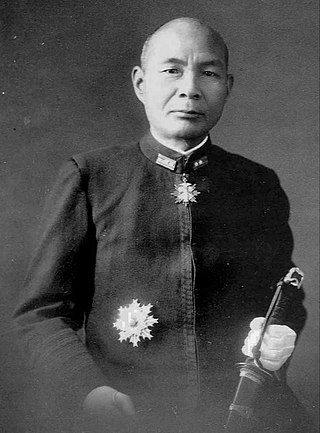
Matome Ugaki was an admiral in the Imperial Japanese Navy during World War II, remembered for his extensive and revealing war diary, role at the Battle of Leyte Gulf, and kamikaze suicide hours after the announced surrender of Japan at the end of the war.

The British Military Administration (BMA) was the interim administrator of British Malaya from August 1945, the end of World War II, to the establishment of the Malayan Union in April 1946. The BMA was under the direct command of the Supreme Allied Commander South East Asia, Lord Louis Mountbatten. The administration had the dual function of maintaining basic subsistence during the period of reoccupation, and also of imposing the state structure upon which post-war imperial power would rest.

The Japanese Cemetery Park is a Japanese cemetery and park in Hougang, Singapore. It is the largest Japanese cemetery in Southeast Asia at 29,359 square metres, consisting of 910 tombstones that contain the remains of members of the Japanese community in Singapore, including young Japanese prostitutes, civilians, soldiers and convicted war criminals executed in Changi Prison. It was gazetted as a memorial park by the Singapore government in 1987.

The Bombing of Singapore (1944–1945) was a military campaign conducted by the Allied air forces during World War II. United States Army Air Forces (USAAF) long-range bomber units conducted 11 air raids on Japanese-occupied Singapore between November 1944 and March 1945. Most of these raids targeted the island's naval base and dockyard facilities, and minelaying missions were conducted in nearby waters. After the American bombers were redeployed, the British Royal Air Force assumed responsibility for minelaying operations near Singapore and these continued until 24 May 1945.

Operation Kita was conducted by the Imperial Japanese Navy (IJN) during the Pacific War in February 1945. Its purpose was to return two Ise-class hybrid battleship-aircraft carriers and four escort ships to Japan from Singapore, where they had been based since November the previous year. The movement of the Japanese force was detected by the Allies, but all attempts to attack it with submarines and aircraft failed. Nevertheless, as a result of the intensifying Allied blockade of Japan, the Ise-class battleship-carriers and their escorts were among the last IJN warships to safely reach the country from the Southwest Pacific before the end of the war.
Operation Mailfist was a planned Allied offensive to liberate Singapore from Japanese occupation during World War II. It was intended to follow on from the landing in Malaya, Operation Zipper, and take place between December 1945 and March 1946. However, it was not conducted as Japan surrendered shortly before Operation Zipper was to have been launched. Instead, Singapore was re-occupied in the unopposed Operation Tiderace.
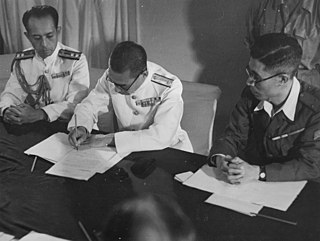
Operation Jurist referred to the British recapture of Penang following Japan's surrender in 1945. Jurist was launched as part of Operation Zipper, the overall British plan to liberate Malaya, including Singapore.
The Yanagi missions, or more formally the Submarine Missions to Germany, were a series of submarine voyages undertaken by the Imperial Japanese Navy (IJN) during the Second World War, to exchange technology, skills and materials with Japan's Axis partners, principally Nazi Germany. These voyages had to run the gauntlet of the Western Allies naval superiority in the Indian and Atlantic Oceans; of the five westbound voyages, three arrived safely, with two submarines sunk en route, while of the three successful vessels only one completed her return voyage, with two sunk before reaching home.


